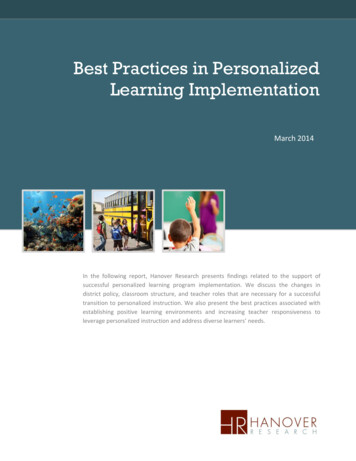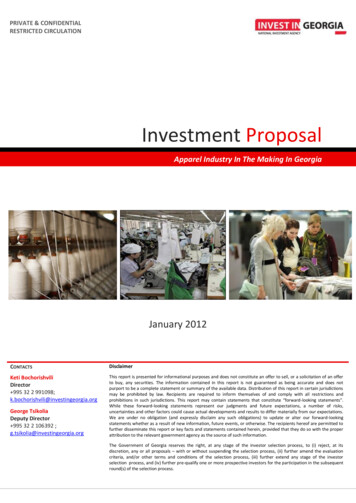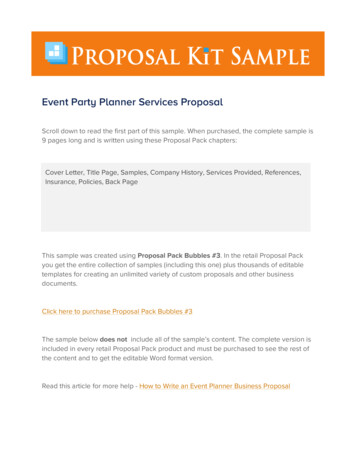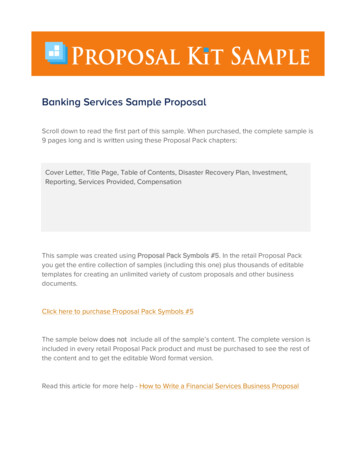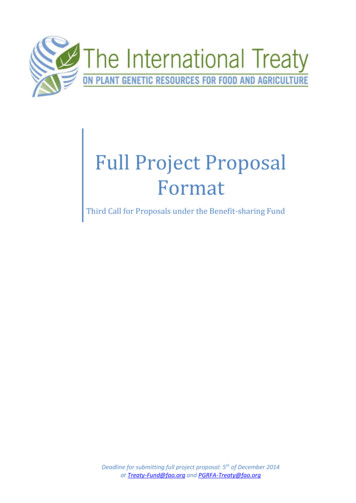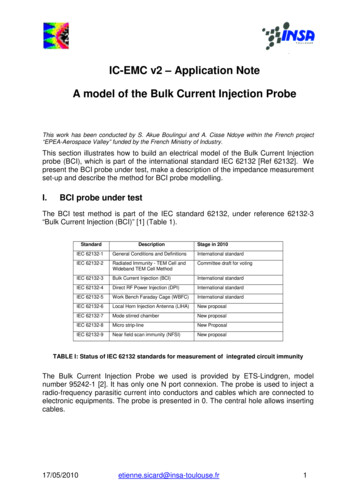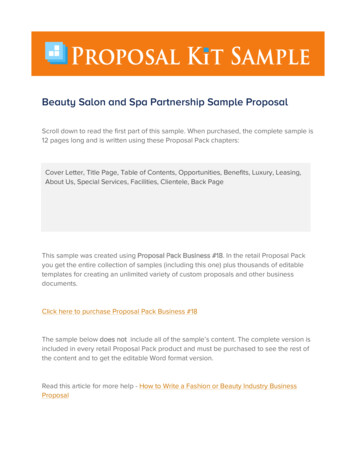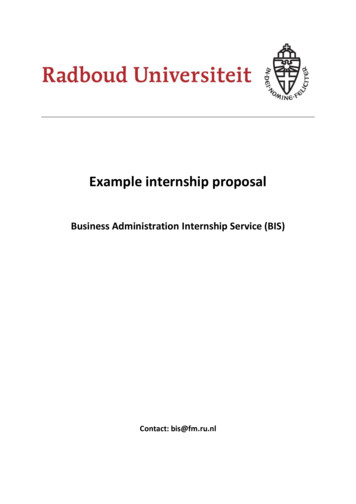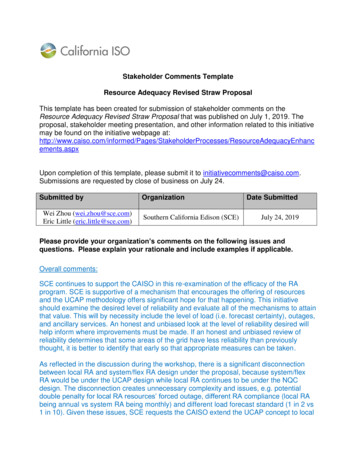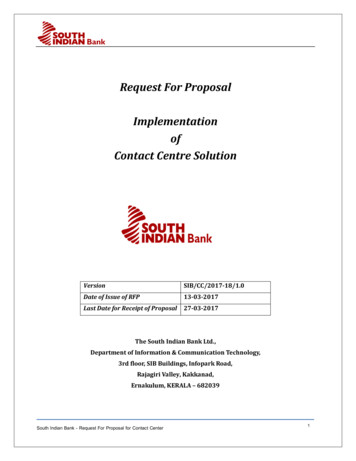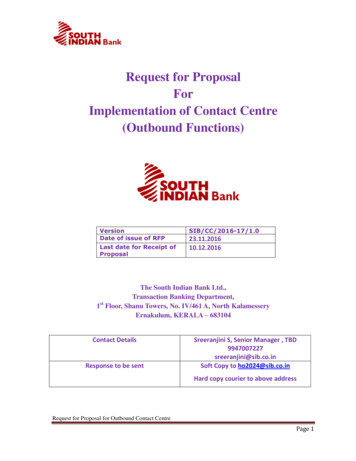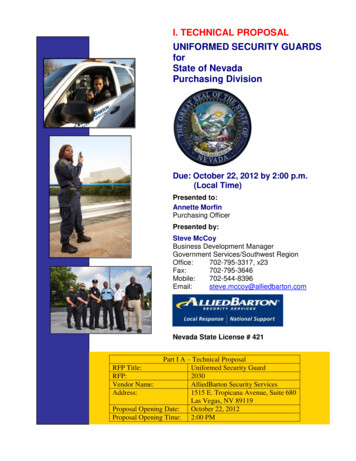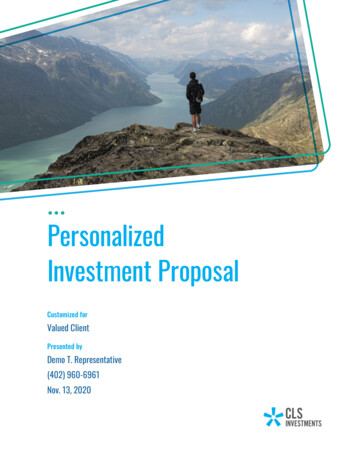
Transcription
CLS TealCLS WhitePersonalizedInvestment ProposalOAS GrayCustomized forValued ClientPresented byDemo T. Representative(402) 960-6961Nov. 13, 2020
CLS TealCLS WhiteWelcomeOAS GrayDear Valued Client,Together, CLS Investments, LLC (CLS) and I have created a customized investmentproposal for you. This proposal outlines my recommendations for investment strategiesand management of your account in accordance with your specific financial goals. Thoseobjectives, which are outlined in this document, have been established in accordancewith the profile information you provided.Specifically, this investment proposal: Establishes reasonable expectations, objectives, and guidelines for the investment ofyour portfolio. Sets forth an investment structure detailing the expected initial allocation among assetclasses. Creates the framework for a well-diversified asset mix that we believe will produce longterm returns in accordance with your level of risk.You, CLS, and I each have distinct and important roles in the investment process: Your role is to communicate your objectives, goals, and desired risk level by updatingyour investment profile when life changes occur. CLS will monitor the funds within your portfolio on a daily basis. If market conditionswarrant, CLS will follow a disciplined money management approach to reallocate yourportfolio, while still seeking to meet your investment objectives. Name will provide oversight to the entire process, meet with you regularly, and workclosely with CLS.I have conducted diligent research to choose a professional money managerwhose investment philosophy and methodology support your goals. CLS and I workcollaboratively to help you achieve your long-term investment objectives.Thank you for reviewing this proposal. Please contact me if you have any questions aboutthese recommendations, CLS, or your financial portfolio in general.Sincerely,Demo T. Representative(402) 960-69612 Date Valued Client
About CLS InvestmentsCLS TealCLS WhiteOAS GrayIn 1972, W. Patrick Clarke began his career as a stockbroker during a time when others were strugglingto survive in the profession. In 1975, he left to focus on working with individual investors to develophighly customized financial plans and investment management options. When other financial plannersbegan identifying the need for this individualized approach, he began to partner with them as a thirdparty asset manager. In 1989, Mr. Clarke was the majority partner in creating Clarke Lanzen SkallaInvestment Firm, LLC., an independent asset allocation firm. Mr. Clarke founded the firm on thelessons he learned as both a financial advisor and an individual investor. Under Mr. Clarke’s direction,the company would eventually become CLS Investments.Today, CLS is an industry-recognized ETF strategist working with more than 4,700 financial advisors tomanage over 47,000 investor portfolios.1 With close to 9 billion in assets under management, and as apart of Orion Advisor Solutions, LLC, CLS has the investment experience to help advisors and individualinvestors achieve financial success.CLS’s Investment TeamCLS’s Investment Team is responsible for theday-to-day management of CLS’s investmentportfolios, as well as providing ongoing supportand guidance to CLS’s advisors and investors.The team comprises six individuals;five Chartered Financial Analyst (CFA ) holders,one Chartered Market Technician (CMT ),one Certified Investment Management Analyst(CIMA ), and one Chartered Alternative InvestmentAnalyst (CAIA ).CLS makes a significant investment in leadinginvestment research, performancemeasurement, and risk management toolsto ensure the Investment Team has access tovaluable information necessary for prudentasset management.These leading industry tools include: 1Morningstar DirectBloombergMATLABFrontline SolverValue LineAs of September 30, 2020 FactSetNed Davis ResearchETF Provider ResearchTrading Desk ResearchMarket-QTimothy HollandRusty VannemanOrion Advisor SolutionsChief Investment Officer(CIO)Orion Advisor SolutionsChief InvestmentStrategistCFA Case EichenbergerCIMA CFA , CMTGrant EngelbartCFA , CAIASenior Client PortfolioManagerDirector of Research& Senior PortfolioManagerMichael HaddenJackson LeeAssociate PortfolioManagerQuantitative PortfolioManagerCFA CFA 3 Date Valued Client
INVESTMENT PROPOSALPrepared for: Valued ClientRisk Budget: X0Registration Type:Account DetailClient Name:Valued ClientRegistration Type:IRAInvestment Amount: 250,000.00Risk Budget:80Custodian:CTCStrategy InformationInvestment OutcomeAccumulationStrategy NameAmerican Funds StrategyAllocation %100%Allocation 250,000.004 Date Valued Client
INVESTMENT PROPOSALPrepared for: Valued ClientRisk Budget: X0Registration Type:Investment OutcomeAccumulationYour portfolio will be focused on total return, meaning growth ofvalue through interest, capital gains, and dividends proportionate toyour risk tolerance.For investors whose primary investing objective is to increaseportfolio value over the long term, CLS builds balanced, globalportfolios constrained by its Risk Budgeting Methodology. This meansCLS accesses many areas of the domestic and international marketsto find the best opportunities that fit within your Risk Budget. CLSemploys a consistent portfolio management process that allows forflexibility and customization to your specific accumulation goals.Your CLS Accumulation portfolio is actively managed, meaning CLSmakes adjustments to it in an effort to maintain an appropriate risklevel and take advantage of opportunities in the market.5 Date Valued Client
INVESTMENT PROPOSALPrepared for: Valued ClientRisk Budget: X0Registration Type:Investment StrategyAmerican FundsAllows you to hire CLS as the professional manager of your AmericanFunds portfolio in order to take advantage of CLS’s disciplined andflexible Risk Budgeting investment management approach.American Funds, like a majority of actively managed mutual funds,tend to drift in their style, capitalization, asset allocation, and riskcharacteristics. CLS’s management of your American Funds portfolioadds value through risk and allocation management.CLS American Funds portfolios are 100% invested in American Fundsinvestments and focus on total return, meaning growth of valuethrough interest, capital gains, and dividends, proportionate to yourrisk tolerance. Each portfolio is actively managed, meaning CLS makesadjustments to it in an effort to maintain an appropriate risk leveland take advantage of opportunities in the market. CLS also carefullymonitors the holdings within the American Funds utilized to maintainglobal diversification in your portfolio. In addition, CLS providesdaily account maintenance, meaning they facilitate all requests forwithdrawals, required minimum distributions, deposits, and RiskBudget changes.American Funds are renowned for their managers’ stock-pickingexpertise and long-term focus. This skill and philosophy makes thesefunds a complement to CLS’s Risk Budgeting and asset allocationspecialization, which is why CLS has included American Funds in manyof their Risk-Budgeted portfolios since 1998.6 Date Valued Client
Prepared for: Valued ClientINVESTMENT PROPOSALRisk Budget: 80Registration Type: IRAAllocation OverviewPortfolio Allocation: Asset therPortfolio Allocation: Asset Class Segments0%5%10%15%20%25%Large-Cap ValueDeveloped InternationalEmerging MarketsLarge-Cap CoreGlobalIntermediate/Long-Term BondsOtherThe graphs and charts contained in thiswork are for informational purposes only.No graph or chart should be regarded asa guide to investing.7 Date Valued Client
Prepared for: Valued ClientINVESTMENT PROPOSALRisk Budget: 80Registration Type: IRAHoldings SummaryFor your assets held at CTCInvestment PortfolioAmerican Funds Strategy/CTCTickerSharesPrice Per ShareMarket ValueAllocation %American Funds Mut;F3AFMFX1,191.67 39.86 47,500.00 19.00%American Funds DWGI;F3FDWGX3,870.67 10.98 42,500.0017.00%American Funds IG&I;F3IGAIX925.662 35.11 32,500.0013.00%American Funds FInv;F3FUNFX365.497 61.56 22,500.009.00%American Funds Wash;F3FWMIX498.118 45.17 22,500.009.00%American Funds Invmt Co of Amer F3FFICX503.018 39.76 20,000.008.00%American Funds EuPc;F3FEUPX309.078 56.62 17,500.007.00%American Funds NPer;F3FNPFX397.637 44.01 17,500.007.00%American Funds Bond;F3BFFAX1,301.04 12.49 16,250.006.50%American Funds SMCP;F3SFCWX175.994 56.82 10,000.004.00%Cash or Cash EquivalentsQFWP-- 1,250.000.50% 250,000.00100.00%TOTALHoldings as of the date this report was generated.Actual holdings may differ.8 Date Valued Client
Our Investment Philosophy & ProcessCLS TealCLS WhiteOAS GrayThe term “risk” as it relates to investing may have negative or scary connotations in your mind. And itis true that riskier assets have a greater chance of decreasing in value at some point. Yet, taking on riskin the investment world can also bring reward, as riskier investments tend to have greater potentialto significantly increase in value. The key is to find a balance between lower risk and higher riskinvestments that is appropriate for your specific investment objectives.That’s where CLS comes in – CLS has been building individualized, balanced, global portfolios since1989. CLS’s Risk Budgeting Methodology is the foundation of its portfolio construction process.CLS starts by defining your personalized Risk Budget, based on your unique investing time horizonand specific investment goals. This budget, which is expressed as a percentage of the risk of a welldiversified, global equity portfolio, represents the amount of risk you are comfortable taking on inexchange for potential returns. Your individual Risk Budget is the risk level at which CLS managesyour portfolio.CLS holds three important beliefs about investment risk that guide us in building your portfolio:1All investors have a capacityto bear risk, and the bestway to manage risk is tomeasure it, rather thanrelying on a traditionalstock-to-bond ratio.2Over the long term,investors are rewarded forbearing risk; having too littlerisk hurts investor returns.3Investment methodologiesshould be designed topair a disciplined riskmanagement system withan active and flexibleapproach.The Risk BudgetA Risk Budget is essentially a percentage of the risk of a diversified, global equity portfolio. CLS tiesthe Risk Budget to the global stock market, which is a benchmark that can be used to evaluate theperformance of your portfolio. The global stock market is a blended index, comprised of about halfdomestic equity and about half international equity. As an example, if your Risk Budget is 80, CLS willmanage your portfolio to take approximately 80% of the risk of the global stock market over time. Youshould also expect that over time, the long-term performance goal for your portfolio is to achieve atleast 80% of the return of the global stock market.CLS’s Global PhilosophyCLS’s philosophy of pursuing global portfolio diversification means that the CLS Portfolio ManagementTeam can look in many areas of the world for investments that offer an optimal balance of risk andreturn. This flexible investment approach gives CLS the best opportunity to adapt portfolios whenmarkets change, as certain asset classes are likely to perform well even when others are not.9 Date Valued Client
Discipline & FlexibilityCLS’s methodology is unique in that it pairs a disciplined risk management system with a flexibleapproach to asset allocation, thus enabling the CLS Portfolio Management Team to create activeportfolios targeting a particular level of risk. Many investment managers use a stock-to-bond ratioapproach to control risk with a portfolio, but CLS does not believe this method is a precise enoughmeasure of actual portfolio risk.For example, what if the equity market risk increases due to high valuations? CLS’s active assetallocation would reduce exposure to overvalued equities while adding exposure to undervaluedequities and fixed income to keep risk consistent. On the other hand, a static stock-to-bond approachwould end up taking on too much risk.CLS’s ACTIVE ASSET ALLOCATIONCLS’s active asset allocation adjusts to account for changing market conditions. As a result, the relative risk in yourportfolio should remain fairly constant over time.Normal U.S. ValuationsRisk Budget 65Higher U.S. ValuationsRisk Budget 65Lower U.S. ValuationsRisk Budget 65STATIC ASSET ALLOCATIONA static asset allocation keeps the portfolio’s allocation constant from year-to-year, even though risk in the market ischanging. As a result, the portfolio’s level of risk may change each year and may not be in line with your Risk Budget.Normal U.S. ValuationsRisk Budget 65Domestic Large-CapHigher U.S. ValuationsRisk Budget 80Domestic Small/Mid-CapLower U.S. ValuationsRisk Budget 50Developed InternationalEmerging MarketsFixed IncomeChanges to Your Investment PortfolioCLS’s focus on managing risk instead of allocating portfolios according to a stock-to-bond ratio gives usincreased flexibility over other asset managers. By examining the actual risk of investment choices, wecan discover relationships that others may miss.There are two general reasons CLS makes changes within your investment portfolio:1The risk of underlying assets changes.2The attractiveness of underlying assets changes.10 Date Valued Client
Asset AllocationCLS TealCLS WhiteOAS GrayCLS’s unique and consistent risk management process is critical in helping you reach your long-terminvestment objectives. It is designed to provide stability to your portfolio and peace of mind thatyour investments are being maintained at the level of risk you are comfortable with, regardless ofwhat is happening in the market. In addition, by globally diversifying your investments among over100 asset class segments and strategies, CLS seeks to minimize portfolio volatility while pursuingareas of opportunity in the market, all within the constraints of your Risk Budget.Commonly-Tracked Asset ClassesEquitiesInternationalLarge CapMid CapBondsGovernmentCorporateHigh YieldSmall CapSample Asset Class Segments and Strategies CLS comeMega rge CapEmergingHigh YieldInflationBase MetalsMid CapSmall ll rgyMicro ativesMunicipalsEach asset CLS tracks is assigned a risk score, which allows different types of assets to be compared,regardless of whether they are stocks, bonds, or even commodities. Risk Budgeting allows assetclasses to be analyzed together to see which is the most attractive, which is not possible when the onlyconsideration is whether an asset is an equity or a bond. By tracking a multitude of asset classes, CLS isable to better focus on an individual asset’s actual risk.11 Date Valued Client
Estimating Risk PotentialCLS uses a combination of two risk measures with quantitative inputs in conjunction with quantitativeand qualitative investment analysis of asset classes to estimate risk and overall return potential.RISK MEASURESMeasures riskof eachasset classA measure of correlated volatility relative to theequity baseline portfolio.67% - Beta33% - Relative Risk(Standard Deviation)1-YearA measure of portfolio risk relative to the market’stotal risk.3-Year5-Year10-YearThese two risk measures areconsidered across four timeframes equally: 1-Year, 3-year,5-Year, and 10-Year.BetaRelative RiskEstimating Return PotentialThe goal of investment analysis is to analyze the attractiveness of an asset not only based on itsrisk, but also on the return potential the asset may bring to the portfolio. Consistent with our overallapproach, CLS relies on a set of quantitative inputs and qualitative evaluations of asset classes toestimate overall return potential. CLS portfolio managers focus on five characteristics when analyzingthe attractiveness of a security: economic, fundamental, statistical, technical, and valuation.ESTIMATED RETURN ANALYSISValuationBehavioralMeasuresoverall returnpotentialFundamentalEconomicQuantitativeThe price paid for earnings, cash flow, salesand book value in different market segments.Used to evaluate securities by analyzingtechnical measures and investor sentiment.Asset-specific information such as business risk,earnings, and expected earnings growth.How an asset will be affected by macrovariables such as economic growth, inflation,and interest rates.Used to capture a variety of measures, includingcost, risk, and correlation analysis.12 Date Valued Client
CommunicationCLS TealCLS WhiteOAS GrayPDF and VideoQuarterly StatementsMarket Discussions& UpdatesWebsiteCLS will make available to you an individual Quarterly PerformanceEvaluation at the end of each quarter in both PDF and video formats,which you can review with this investment proposal to determinewhether you are meeting your goals. The proposal will help you keepin mind your investment objectives, time horizon, and expected rate ofreturn. Your Quarterly Performance Evaluations are available on the webat www.CLSinvest.com.Communication with both you and your financial representative isimportant. Each quarter, CLS will make available to you our Directionsnewsletter, which contains information about the latest market andeconomic conditions. Directions are available online at www.CLSinvest.com.Additionally, you can view our Quarterly Market Outlook video andsupplemental materials directly from our Portfolio Management Teamby visiting www.CLSinvest.com/QMO.Log on to www.CLSinvest.com for secure access to your quarterlyperformance evaluations, daily positions and values, and otherportfolio information. In addition, our website provides a direct lineof communication between you and our Service Team through the“Contact Us” link on our home page.The CLS mobile app is available for mobile devices and provideson-the-go account access to:CLS Mobile App Account holdings Statements and reports Shares, values, prices, and performanceYou can also call or email your financial representative directly fromthe app.To download the CLS mobile app, visit the app store on your deviceand search for “CLS mobile.”For market commentary, portfolio positioning, links to important industrynews, and company and product updates:CLS is Social Blog: blog.clsinvest.com Twitter: @clsinvestments LinkedIn: linkedin.com/company/CLS-investments-llc Facebook: Facebook.com/clsinvest13 Date Valued Client
DisclosuresThis material does not constitute any representation as to the suitability or appropriateness of any security, financial product or instrument.There is no guarantee that investment in any program or strategy discussed herein will be profitable or will not incur loss. This informationis prepared for general information only. It does not have regard to the specific investment objectives, financial situation, and the particularneeds of any specific person who may receive this report. Investors should seek financial advice regarding the appropriateness of investingin any security or investment strategy discussed or recommended in this report and should understand that statements regarding futureprospects may not be realized. Investors should note that security values may fluctuate and that each security’s price or value may rise orfall. Accordingly, investors may receive back less than originally invested. Past performance is not a guide to future performance. Individualclient accounts may vary. Investing in any security involves certain risks called non-diversifiable risk. These risks include market risk, interestrate risk, inflation risk, and event risk. These risks are in addition to any specific, or diversifiable, risks associated with particular investmentstyles or strategies.The benchmark for CLS Risk Budgeted strategies is a blended index composed of a set portion of the Equity Baseline Portfolio (EBP) and theBarclay’s Capital 1-3 Month U.S. Treasury Index (Barclay’s). The precise allocation of each benchmark to each index is based solely upon therisk budget of the model. For example, a Core ETF Strategy model with a risk budget of 95 will utilize a benchmark of 95% EBP, 5% Barclay’s,whilst a Core ETF Strategy model with a risk budget of 60 will utilize a benchmark of 60% EBP, 40% Barclay’s.The Equity Baseline Portfolio (EBP) is a blended index comprised of 60% domestic equity (represented by the Russell 3000 Index) and 40%international equity (represented by the MSCI ACWI ex US Index), rebalanced daily. The Russell 3000 Index is an unmanaged index consideredrepresentative of the U.S. stock market. The index is composed of the 3,000 largest U.S. stocks. The MSCI All-Countries World Index, excludingU.S. (ACWI ex US) is an index considered representative of stock markets of developed and emerging markets, excluding those of the US.The Barclay’s Capital 1-3 Month U.S. Treasury Bill Index includes all publicly issued zero-coupon U.S. Treasury Bills that have a remainingmaturity of less than 3 months and more than 1 month, are rated investment grade, and have 250 million or more of outstanding face value.CLS Risk Budgeted strategies are considered diversified portfolios which may invest in Exchange Traded Funds, or ETFs, individual stocks,or bonds. The strategies will target specific sectors or investment methodologies which, depending on the strategy, may include domesticlarge, mid, and small cap equities, international equities, value investing, commodities, natural resource companies, real estate investmenttrusts, master limited partnerships, convertible bonds, senior bank loans, high yield bonds, government debt, preferred stock, managedfutures, derivatives, high quality, and low volatility. There are additional risks associated with investment in these sectors or utilizing thesemethodologies.An ETF is a type of investment company whose investment objective is to achieve the same return as a particular index, sector, or basket. Toachieve this, an ETF will primarily invest in all of the securities, or a representative sample of the securities, that are included in the selectedindex, sector, or basket. ETFs are subject to the same risks as an individual stock, as well as additional risks based on the sector the ETFinvests in.Small or mid-cap companies are less predictable than large or mega-cap companies. Earnings are less predictable, shares are more volatile,and such companies generally fluctuate in value much more than large cap companies.Developed international securities and American Depository Receipts may be subject to fluctuations in the exchange rate, varying degreesof market regulations within the foreign country, lower liquidity and increased volatility as compared to US securities, additional taximplications, and political, economic, or social instability. Emerging markets may experience risks similar to developed nations but to a fargreater degree. The stage of economic development of the country will be directly related to the amount of risk within that country’s market.Value investing refers to investment in undervalued securities in an effort to achieve greater overall returns. A security which is consideredundervalued might never achieve the level of return projected by an investor. As such, value investing is subject to liquidity risks in additionto the general business risk.Commodity instruments may be affected by changes in overall market movements, commodity index volatility, changes in interest rates, orfactors affecting a particular industry or commodity, such as drought, floods, weather, livestock disease, embargo, tariffs, and internationaleconomic, political, and regulatory developments.Real Estate Investment Trusts are subject to decreases in value, adverse economic conditions, overbuilding, competition, fluctuations inrental income, and fluctuations in property taxes and operating expenses.A Master Limited Partnership (MLP) is a partnership which is publicly traded with at least 90% of capital coming from real estate, naturalresources, and commodities. As such, MLPs are subject to all of the underlying risks of these investments.Convertible securities will generally involve lower credit risk than a common stock as convertible securities are senior to common stock.Convertible securities generally pay lower dividends and interest than non-convertible securities.Senior Bank Loans are loans generally secured by a lien against a specific asset and are the first to be repaid in the event of a bankruptcy.While the business risk is lower than that of an unsecured loan, the risk is still present.High Yield Bonds, also known as “junk bonds” are bonds with low credit ratings. Investors generally invest in high yield bonds due to theprospect of greater than average interest payments. High yield bonds are subject to a greater degree of the business risk, credit risk, and theliquidity risk as opposed to a medium-grade or investment-grade corporate debt security.A derivative is a contract which may include futures contracts, forward contracts, options, and swaps, which are based on an underlyingasset such as a stock, bond, commodity, currency, etc. The risk of the derivative for the writer will be closely related to that of the underlyingasset.The CFA is a globally respected, graduate-level investment credential established in 1962 and awarded by CFA Institute — the largest globalassociation of investment professionals. To learn more about the CFA charter, visit www.cfainstitute.orgThe CMT Program demonstrates mastery of a core body of knowledge of investment risk in portfolio management. The Chartered MarketTechnician (CMT) designation marks the highest education within the discipline and is the preeminent designation for practitioners oftechnical analysis worldwide. To learn more about the CMT, visit https://cmtassociation.org/CIMA professionals integrate a complex body of investment knowledge, ethically contributing to prudent investment decisions by providingobjective advice and guidance to individual investors and institutional investors. To learn more about the CIMA, visit https://www.imca.org/cimaThe CAIA is the globally-recognized credential for professionals managing, analyzing, distributing, or regulating alternative investments. Tolearn more about the CAIA, visit https://caia.org14 Date Valued Client
3342-CLS-12/14/202015 Date Valued Client
American Funds Bond;F3 BFFAX 1,301.04 12.49 16,250.00 6.50% American Funds SMCP;F3 SFCWX 175.994 56.82 10,000.00 4.00% Cash or Cash Equivalents QFWP - - 1,250.00 0.50% TOTAL 250,000.00 100.00% For your assets held at CTC American Funds Strategy/C
